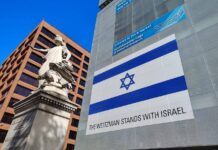Israeli Prime Minister Benjamin Netanyahu led an assessment of the Israel Defense Forces deployment on the northern border with Syria on Tuesday afternoon, his office said.
Netanyahu visited the Mt. Hermon peak with Defense Minister Israel Katz, IDF Chief of Staff Lt. Gen. Herzi Halevi, Northern Command head Maj. Gen. Ori Gordin, Israel Security Agency (Shin Bet) head Ronen Bar and other security officials.
Netanyahu during the visit “reviewed the IDF deployment in the area and set guidelines for the future,” according to the PMO statement.
“We are holding this assessment in order to decide on the deployment of the IDF in this important place until another arrangement is found that ensures Israel’s security,” the prime minister stated in his remarks.
“This is nostalgic for me. “I was here 53 years ago with my soldiers in the General Staff Reconnaissance Unit [“Sayeret Matkal”]. The place has not changed,” Netanyahu said. “It is the same place, but its importance for Israel’s security has only been underscored in recent years; especially in recent weeks with the dramatic events that took place below us in Syria.”
“We will determine the best arrangement that will ensure our security,” the premier concluded.
בהערכת מצב היום בשיא החרמון – ומכאן, עדכון ממני אליכם >> pic.twitter.com/z7koKABxfm
— Benjamin Netanyahu – בנימין נתניהו (@netanyahu) December 17, 2024
“The peak of Mt. Hermon serves the eyes of the State of Israel to detect near and far threats,” Katz said according to a Defense Ministry readout.
“The IDF is here to protect the communities of the Golan Heights and the citizens of the State of Israel from any threat, from the most important place to do so,” continued the defense minister.
“Our presence here at the peak of the Hermon strengthens security and adds a dimension of both observation and deterrence to Hezbollah’s strongholds in the Beqaa Valley in Lebanon and deterrence against the rebels in Damascus, who pretend to present a moderate image, but belong to the most extreme Islamist sects,” he concluded.
The statement was issued shortly after the PMO denied reports that Netanyahu was heading to Cairo to seal a ceasefire deal with Hamas.
Earlier on Tuesday, the leader of Syria’s Islamist Hayat Tahrir al-Sham (HTS) group, which spearheaded the toppling of the Assad regime, said that the rebel alliance in Damascus would uphold the 1974 Disengagement of Forces Agreement that ended the 1973 Yom Kippur War between Israel and Syria.
According to a New York Times account of an interview given to a group of journalists, HTS head Ahmad al-Sharaa, better known by his nom de guerre, Abu Mohammad al-Julani, also called on the international community to ensure that Israel follows the accord, criticizing the IDF deployment to the demilitarized buffer zone and other areas inside Syrian territory.
Since the fall of the Assad regime, IDF troops have taken up positions in and beyond the buffer zone, including the strategic Syrian side of Mt. Hermon. The Air Force has also conducted hundreds of strikes on military assets of the Assad regime to prevent them from falling into the wrong hands.
























